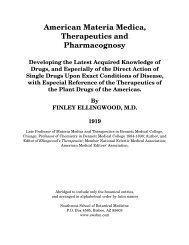SCARLET FEVER. Synonyms.—Scarlatina; Scarlet Rash. Definition ...
SCARLET FEVER. Synonyms.—Scarlatina; Scarlet Rash. Definition ...
SCARLET FEVER. Synonyms.—Scarlatina; Scarlet Rash. Definition ...
You also want an ePaper? Increase the reach of your titles
YUMPU automatically turns print PDFs into web optimized ePapers that Google loves.
The specific cause, the bacillus lepræ, discovered by Hansen in 1874,<br />
resembles the tubercle bacillus, though it may be distinguished from it<br />
by “differential stains,” by their great number, and by their tendency to<br />
form colonies, and to the fact that as yet it has failed to propagate in<br />
inoculation tests.<br />
Pathology.—The tubercles of leprosy are made up of granulomatous<br />
tissue, and consist principally of round cells, in and between which are<br />
found the bacilli in large numbers. These tubercular masses involve the<br />
skin, and, pushing outward, form nodular masses, between which are<br />
seen areas of ulceration and cicatrization, which, in the face, distort the<br />
features, and give rise to the so-called facies leonina.<br />
These tubercular masses caseate, soften, and discharge a thick purulent<br />
material, or partial organization may take place, staying the further<br />
progress of the disease.<br />
The destruction of tissue proceeds gradually, years being occupied in<br />
destroying the patient. The deep, ulcerative process may amputate<br />
fingers and toes in its progressive march—lepra mutilans. When the<br />
bacilli develop in the nerve fibers and their sheaths, a peripheral<br />
neuritis results, with local anesthesia.<br />
Symptoms.—This is a chronic disease, lasting from five to twenty<br />
years before death finally ends what has been, for years, a living death.<br />
Indefinite prodromal symptoms, such as malaise, general depression,<br />
loss of appetite, gastro-intestinal disturbance, may appear months<br />
before the outbreak. Two distinct forms are seen: 1. The nodular, or<br />
tubercular; 2. The anesthetic.<br />
Tubercular Form.—This is the most common form, embracing from sixty<br />
to seventy per cent of all cases. The first suspicious or positive evidence<br />
is the appearance of irregular spots or patches of erythema, more or less<br />
clearly defined and slightly hyperesthetic. These always appear on the<br />
face, though other portions of the body may be involved. After a time,<br />
these may partially or wholly disappear for a season, but always<br />
reappear, generally as circumscribed infiltrated spots. Gradually these<br />
develop into leprous nodules. The nose and lips become thickened and<br />
stiff.<br />
These same tubercular masses appear in the nose, mouth, and throat;<br />
The Eclectic Practice of Medicine - PART I - Infectious Diseases - Page 235

















